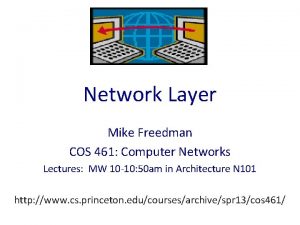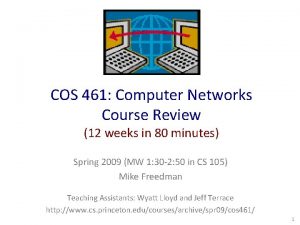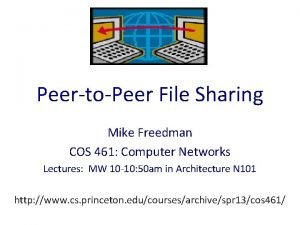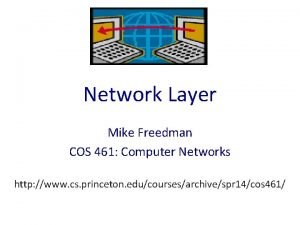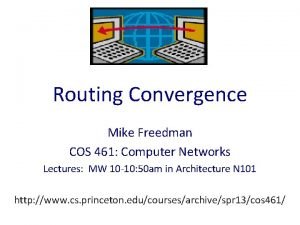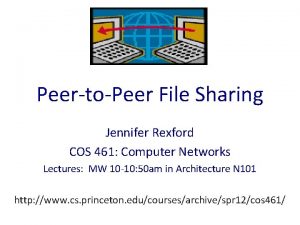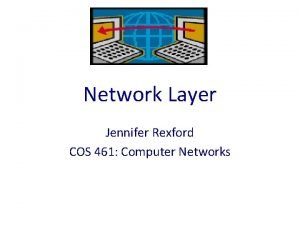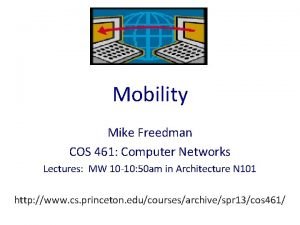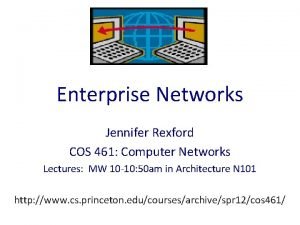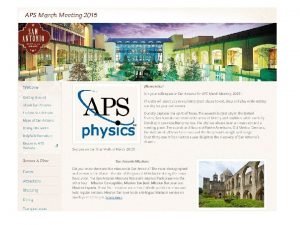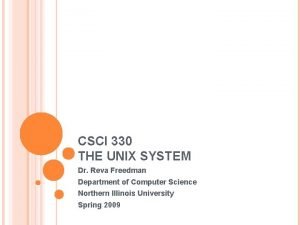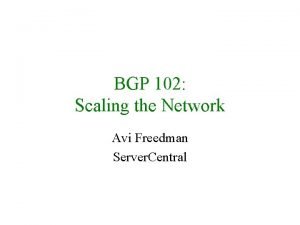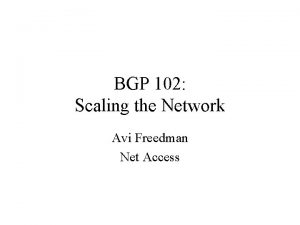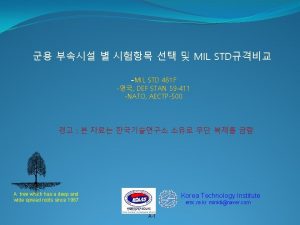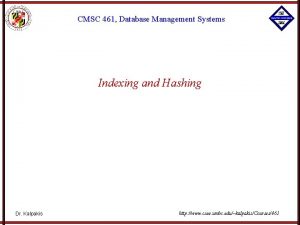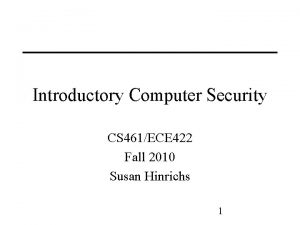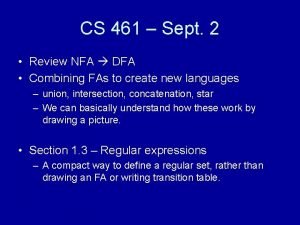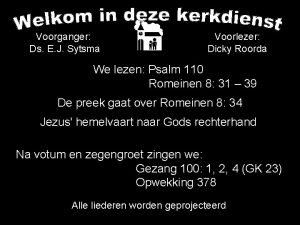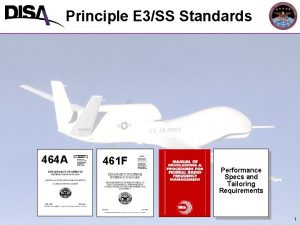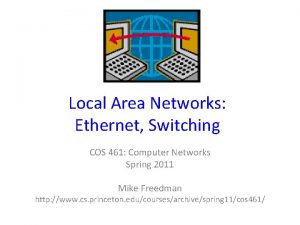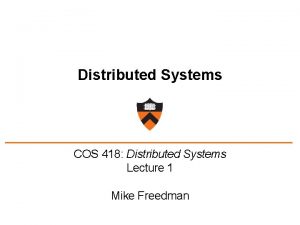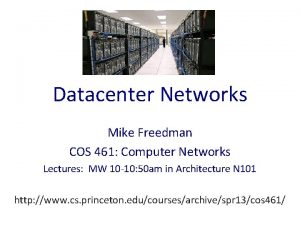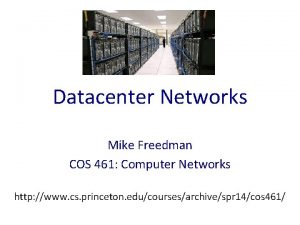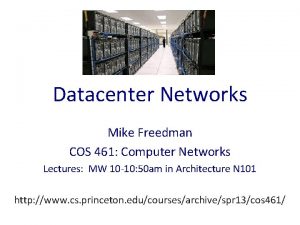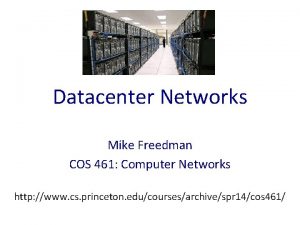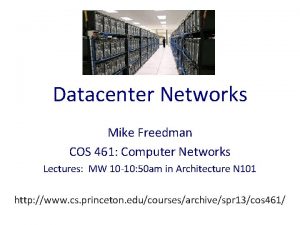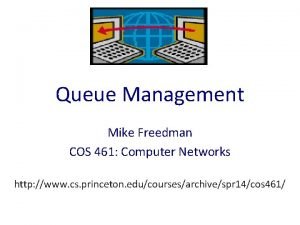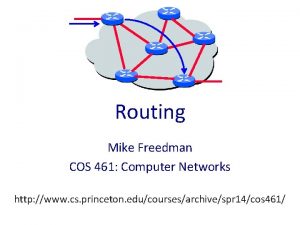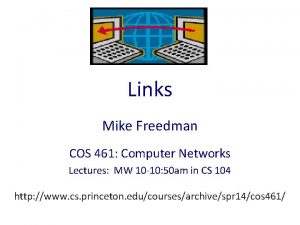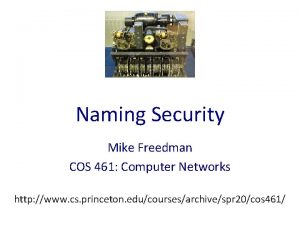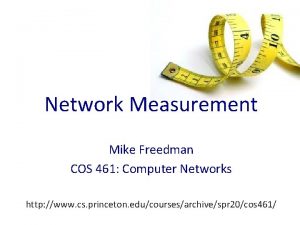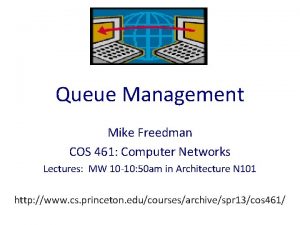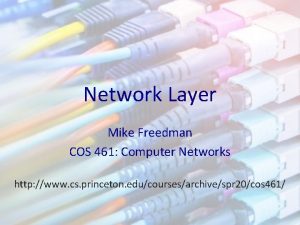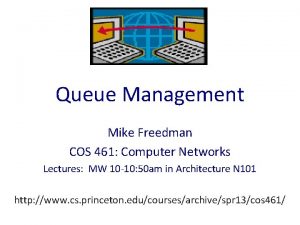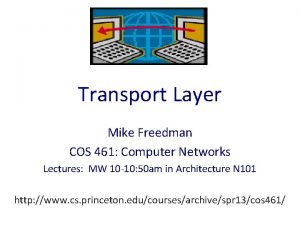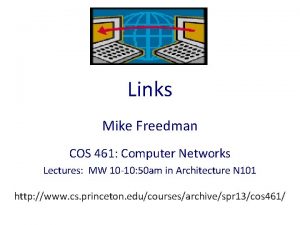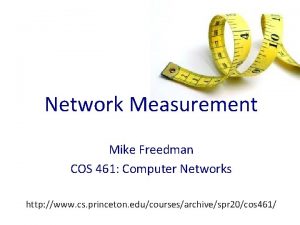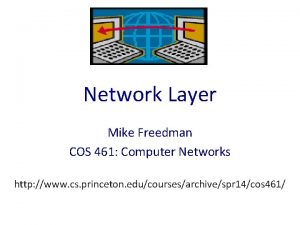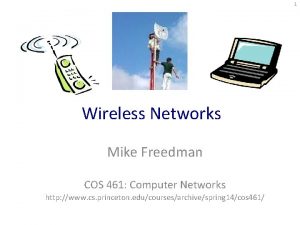COS 461 Computer Networks Mike Freedman Spring 2013








































- Slides: 40

COS 461: Computer Networks Mike Freedman Spring 2013 Lectures: MW 10 -10: 50 am in Architecture N 101 Preceptors: Aaron Blankstein, Scott Erickson, Naga Katta Precepts: F 10 -10: 50 am, F 11 -11: 50 am http: //www. cs. princeton. edu/courses/archive/spr 13/cos 461/

The Internet is an Exciting Place 2

Two Billion Internet Users ~5 Billion Devices (PCs, laptops, smart phones, etc. ) 3

Internet Applications (2010) • Email – 1. 9 B people used email – 294 B emails sent per day • Web – 255 M Web sites – 21. 4 M new Web sites • You. Tube – 2 B videos watched per day – 35 hours of video uploaded per minute • Blogs – 152 M blogs • Twitter – 100 M new Twitter accounts – 25 B tweets • Facebook – 20 M Facebook apps installed per day – 36 B photos uploaded – Estimated 1 B users by 2012 http: //mashable. com/2011/01/25/internet-size-infographic/ 4

How does the design of the Internet support growth and foster innovation? 5

The Internet is a Tense Place 6


Internet Traffic to/from Egypt

Stop Online Piracy Act (SOPA) 9

Network Neutrality FCC Rules Against Comcast P 2 P Throttling The U. S. Federal Communications Commission has ordered Comcast to stop interfering with peer-to-peer traffic on its broadband network… 10

IP Address Space Exhaustion “Currently, the Internet is built using IPv 4, but on February 3, 2011, the global supply of unassigned IPv 4 Internet addresses was exhausted. On that date, the Internet Assigned Numbers Authority has distributed the final five blocks of approximately 16 million IPv 4 addresses among the five Regional Internet Registries. ” 11

Cyber Attacks 12

How does the design of the Internet create or exacerbate these tensions? 13

What is the Internet? 14

I Can Haz Wikipedia The Internet is the worldwide, publicly accessible network of interconnected computer networks that transmit data by packet switching using the standard Internet Protocol (IP). It is a "network of networks" that consists of millions of smaller domestic, academic, business, and government networks, which together carry various information and services, such as electronic mail, online chat, file transfer, and the interlinked Web pages and other documents of the World Wide Web. http: //en. wikipedia. org/wiki/Internet

“Best-Effort Packet Delivery Service” packets THE INTERNET 16

Power at the Edge End-to-End Principle Whenever possible, communications protocol operations should be defined to occur at the end-points of a communications system. Programmability With programmable end hosts, new network services can be added at any time, by anyone. And end hosts became powerful and ubiquitous….

“A Network of Networks” 4 3 2 THE INTERNET 7 5 6 1 Client Browser Web server • How do you name? • How do you find a name? 18

Announcing a Route 4 3 5 2 7 6 1 Client Browser Web server “Egypt is in this direction” 19

Forwarding Traffic 4 3 5 2 7 6 1 Client Browser Web server 20

Withdrawing a traffic route 4 3 5 2 1 Client Browser 7 6 ? ? ? Web server “Egypt is not in this direction” 21


Central concepts in networking 23

Abstraction through Protocol Layering • Modularity – Each layer relies on services from layer below – Each layer exports services to layer above • Interfaces – Hides implementation details – Layers can change without disturbing other layers Application-to-application channels Host-to-host connectivity Link hardware 24

The Internet Protocol Suite FTP HTTP NV TCP TFTP Applications UDP TCP UDP Waist IP Data Link NET 1 NET 2 … NETn Physical The Hourglass Model The “narrow waist” facilitates interoperability 25

Example: Hyper. Text Transfer Protocol GET /courses/archive/spr 13/cos 461/ HTTP/1. 1 Host: www. cs. princeton. edu User-Agent: Mozilla/4. 03 CRLF Request HTTP/1. 1 200 OK Date: Mon, 4 Feb 2013 11: 09: 03 GMT Server: Netscape-Enterprise/3. 5. 1 Last-Modified: Mon, 2 Feb 2013 19: 12: 23 GMT Response Content-Length: 21 CRLF Site under construction 26

Layer Encapsulation in HTTP User A User B Application Get index. html App-to-app channels Connection ID Host-to-host connectivity Link hardware Source/Destination Link Address 27

End Hosts vs. Routers host HTTP message HTTP TCP segment TCP router IP Ethernet interface HTTP IP packet Ethernet interface IP TCP router IP packet SONET interface IP IP packet Ethernet interface IP Ethernet interface 28

Key Concepts in Networking • Naming – What to call computers, services, protocols, … • Layering – Abstraction is the key to managing complexity • Protocols – Speaking the same language – Syntax and semantics • Resource allocation – Dividing scare resources among competing parties – Memory, link bandwidth, wireless spectrum, paths 29

Course Organization 30

What You Learn in This Course • Knowledge: how the Internet works, and why – Protocol stack: link, network, transport, application – Resource allocation: congestion control, routing – Applications: Web, P 2 P, Vo. IP, … – Networks: enterprise, cloud, backbone, wireless, … • Insight: key concepts in networking – Naming, layering, protocols, resource allocation, … • Skill: network programming (in precept!) – Many nodes are general-purpose computers – Can innovate and develop new uses of networks 31

i. Clickers: Quick Surveys Growth/innovation vs. create/exacerbate tensions • Does Internet design prevent misuse? A. Individual endpoints can only use addresses given to them when connect to the network B. Individual end-points can “spoof” any IP address 32

i. Clickers: Quick Surveys Growth/innovation vs. create/exacerbate tensions • Does Internet design prevent misuse? Networks are assigned unique IP address blocks from a central authority (“IANA”): Princeton has 128. 112. * A. Network can only announce assigned addresses B. Networks can spoof any address 33

i. Clickers: Quick Surveys Growth/innovation vs. create/exacerbate tensions • Does “Internet” provide reliable packet delivery? A. Yes, that’s necessary for protocols like HTTP that require in-order streams B. No, packets may be arbitrary dropped or reordered 34

Learning the Material: People • Lecture: Mike Freedman – Slides available online at course Web site • Precept – Aaron Blankstein, Scott Erickson, Naga Katta – Office hours: TBD, based on assignment schedule • Main Q&A forum: www. piazzza. com – Sign up on Piazza now, using your real name – Graded on class participation: so ask and answer! – No anonymous posts or questions – Can send private messages to instructors 35

Precepts • Sign up for precept assignments – 10 am precept: COS Building, 102 – Two 11 am precepts: Sherrerd 101, Friend 004 – See Colleen Kenny-Mc. Ginley if problems: ckenny@cs • We do have precept this Friday • Contact both preceptors ahead of time if need to attend a different precept. 36

Learning the Material: Books • Required textbook – Computer Networks: A Systems Approach (5 th edition), by Peterson and Davie – Okay to use the 3 rd or 4 th edition • Books on reserve – Networking textbooks • Computer Networking: A Top-Down Approach Featuring the Internet, by Kurose and Ross • Computer Networks, by Tanenbaum – Network programming references • TCP/IP Illustrated, Volume 1: The Protocols, by Stevens • Unix Network Programming, Volume 1: The Sockets Networking API, by Stevens, Fenner, & Rudolf 37

Grading • Four assignments (12% each) – 95% 3 hours, 70% 2 days late, 50% > 3 days late – One free late day during the semester – Must complete all assignments to pass • Two exams (45% total) – Midterm exam before spring break (20%) – Final exam during exam period (25%) • Class participation (7%) – In lecture and precept – On Piazza 38

Policies: Write Your Own Code While thinking about a problem, discussions with friends are encouraged. However, when the time comes to write code, the program must be your own work. If you have a question about how to use some feature of C, UNIX, etc. , you can certainly ask your friends or the TA, but do not, under any circumstances, copy another person's program. Allowing someone to copy your program or using someone else's code in any form is a violation of academic regulations. 39

Conclusions • Internet – Diverse, ever-changing applications – … communicating over a network of networks – … using multiple layers of protocols • Wednesday lecture – Links: how do two computers communicate? • Friday precept – Sockets: how do two applications communicate? 40
 Cos 461
Cos 461 Cos 461
Cos 461 Cos 461
Cos 461 Cos 461
Cos 461 Cos 461
Cos 461 Cos 461
Cos 461 Cos 461
Cos 461 Cos 461
Cos 461 Precidr
Precidr Cos
Cos Puwifi
Puwifi Virtual circuit and datagram networks
Virtual circuit and datagram networks Backbone networks in computer networks
Backbone networks in computer networks Young and freedman
Young and freedman Current resistance and electromotive force
Current resistance and electromotive force Sears zemansky
Sears zemansky Danielle freedman
Danielle freedman Rabbi david freedman
Rabbi david freedman Neil freedman
Neil freedman Steve freedman
Steve freedman 461 enneagram
461 enneagram Csci 330
Csci 330 Avi freedman net worth
Avi freedman net worth Avi freedman net worth
Avi freedman net worth Cast of spring, summer, fall, winter... and spring
Cast of spring, summer, fall, winter... and spring Spring is green summer is bright song
Spring is green summer is bright song Mil-std-461f 한글 pdf
Mil-std-461f 한글 pdf Cmsc 461
Cmsc 461 Uiuc cs 461
Uiuc cs 461 Cs 461
Cs 461 Ccna voice 640-461 pdf
Ccna voice 640-461 pdf Kkk 461
Kkk 461 Opwekking 461 tekst
Opwekking 461 tekst Mil-std-464
Mil-std-464 Icvm 461/07
Icvm 461/07 Area 461
Area 461 Ece 422 uiuc
Ece 422 uiuc What is celebrated on march 17
What is celebrated on march 17 Psalm 34 zingen
Psalm 34 zingen Contul 4428
Contul 4428 Cos 418 spring 2021
Cos 418 spring 2021

